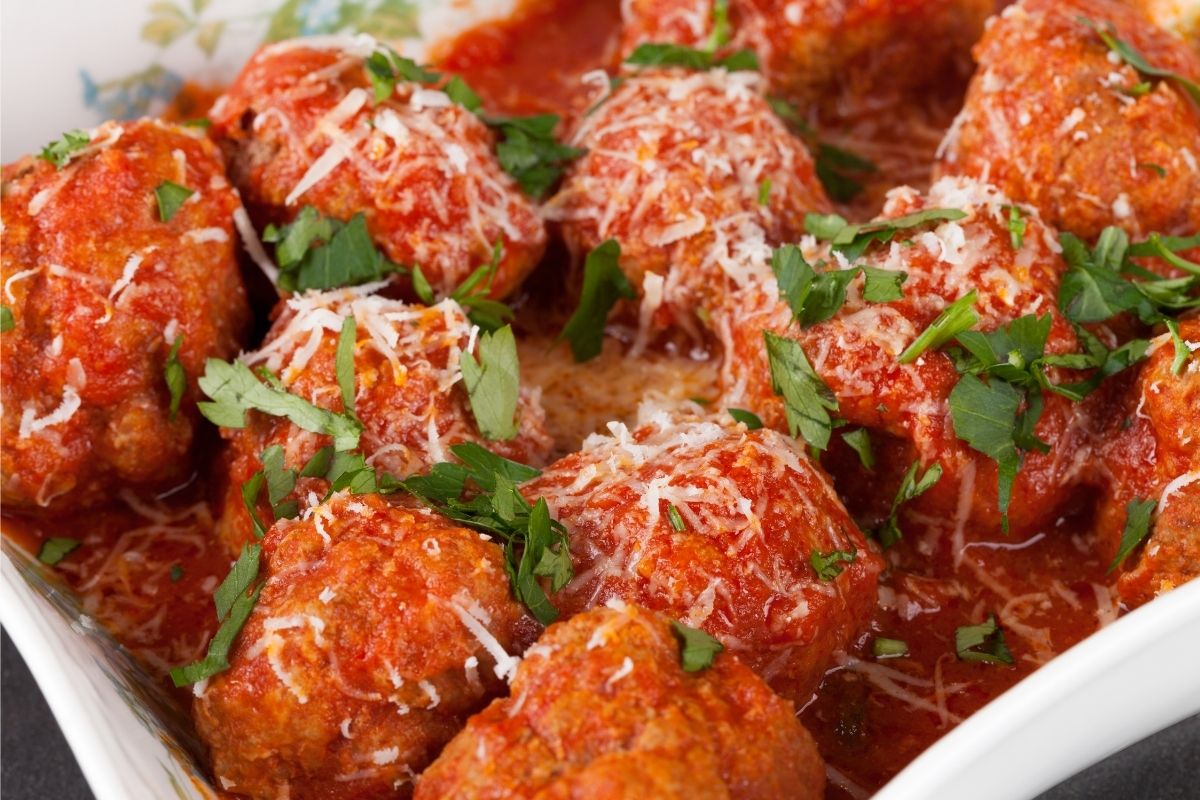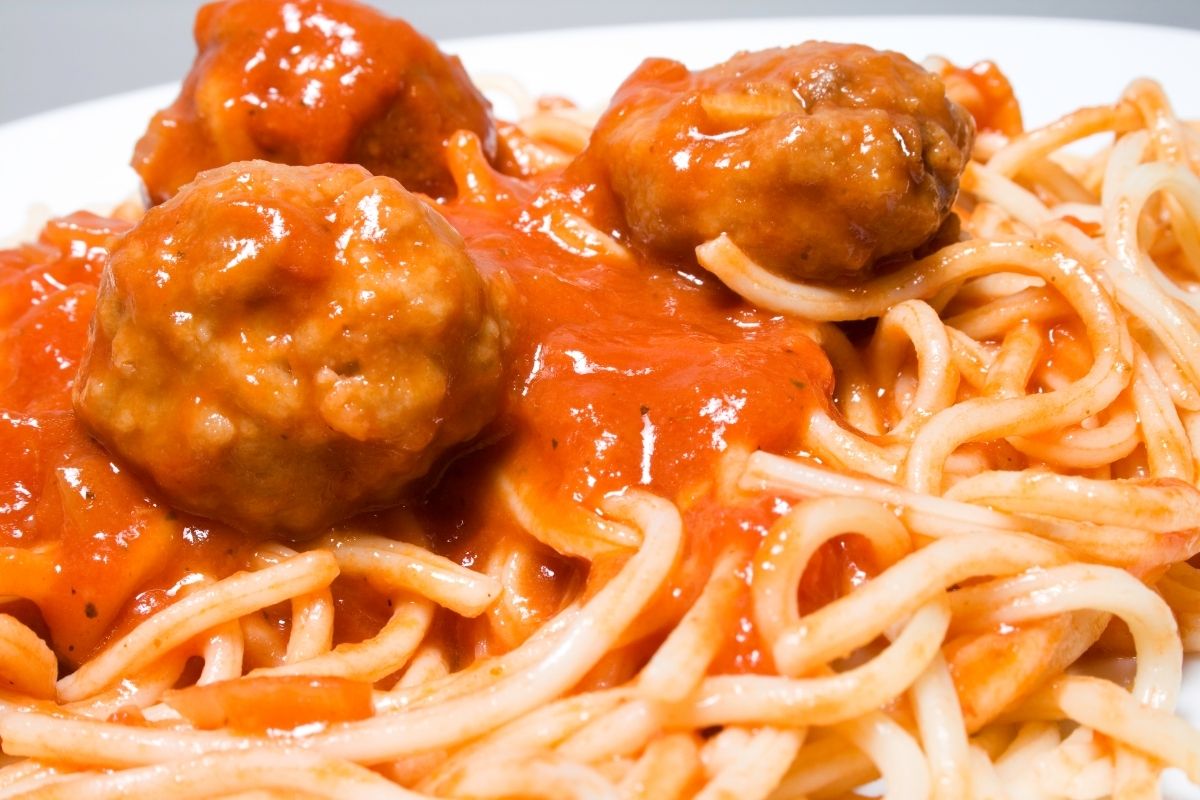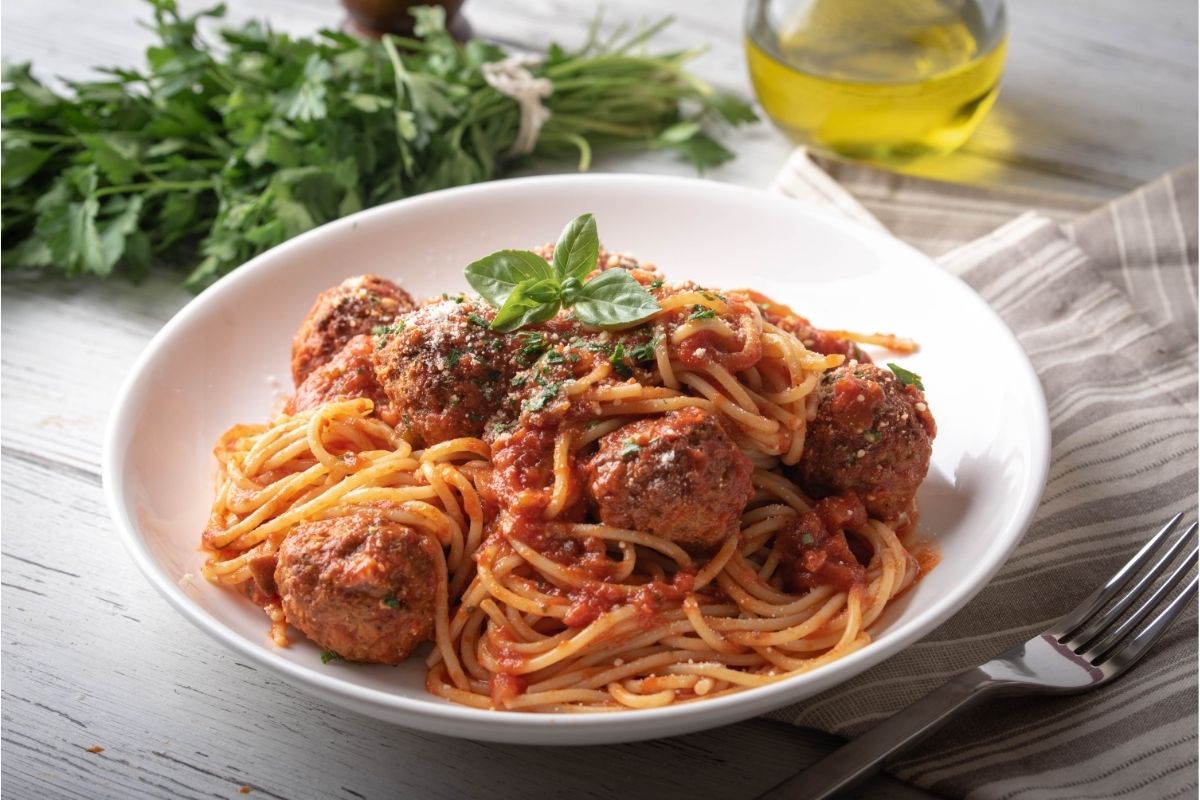Do you know how to make meatballs for spaghetti? If not, it is time to prepare this delicacy the Italian way. Eating Italian meatballs (Polpetta) is a tradition in Italy.
We would like you to become a cook that knows how to make great meatballs for spaghetti. But before we discuss even how to make meatballs for spaghetti in oven, lets us discuss a few basics of Italian meatballs.
The History of Italian Meatballs (Polpetta)
The meatball sauce recipe first appeared in the 1881 manual, La Scienza in Cucina e l’Arte di Mangiar Bene (Science in the Kitchen and the Art of Eating Well) that Pellegrino Artusi wrote.
Artusi termed the recipe for making meatballs simple. His recipe described how to make meatballs from leftover meat. However, meatballs have evolved to become a dish that does not require any recycling of leftover meat.
Today, the meatball recipe includes other valuable ingredients than what Artusi had used. The ingredients include fresh ground beef, ham, and Parmesan. Also, Italians have a unique recipe that features seasoning herbs.
Notably, Italians serve their meatballs and Spaghetti separately. However, Americans serve the two dishes as a combo.
Italians use veal or beef mixed with other ingredients when making meatballs. The ingredients also include garlic, parsley, eggs, and cheese. In America, people think that meatballs always have meat. However, you can use potatoes or fish to make them. When meatballs do not have meat, Italians call them Crocchettes. You can bake or fry Polpetta and Crocchettes.

Are Meatballs Italian? Where are They From Originally?
Reliable sources indicate that Persia is the source of Polpetta. Persians used to call them Kofta, a name crafted from Koofteh (pounded meat). The findings also show that Romans also used to make Polpetta. The great Roman chef, Apicius, used to call Polpetta Esicia Omentata.
However, the Romanian Polpetta does not have the nature of the current meatballs. The Romans mixed myrtle berries, garum, red wine, and pig net (Omentum) to make the meatballs.
Before the fourteenth century, meatballs did not exist in the ancient recipe books. In the fifteenth century, Maestro Marino included them in his Libro de Arte Coquinaria. Martino was a cook in the Aquileia chamberlain Patriarch.
Even though people called the meatballs purpetta, the meatballs were more of a spit roast version than meatballs. However, they represent the first meatball recipe in Italian culinary literature history.
Types and Flavors of Italian Meatballs
Meatballs are a popular dish. People from different regions use any variety of readily-available meat to make them. For example, the Chinese use pork or fish, while North Africans use lamb meat.
In Sweden, you will find smaller meatballs than Italian meatballs. Also, the Swedish serve their meatballs with cream sauce.
In America, meatballs contain beef or ground turkey. In Italy, the Italians fry and serve their meatballs as a snack. They can also serve it as a main course but without any sauce.
Some traditional meatball recipes allow you to mix different ingredients, including Mortadella and chopped salami when making meatballs. Other recipes advise you to place a piece of Fontina cheese on each meatball before frying them. Also, other recipes show you how to make meatballs in the oven for spaghetti.
Regardless of how you prepare your meatballs, you can serve them with Arugula salad or lightly sautéed veggies, including Swiss chard or spinach. However, children will find meatballs tastier when served with French fries.
10 Cool Facts About Spaghetti
We have said so much about meatballs. It is now time to discuss Spaghetti because they are equally yummy. What are some of the cool facts regarding spaghetti?
- Spaghetti is More Than one Thousand Years old
The birth of Spaghetti in Europe a thousand years ago was an outcome of religious and cultural invasion. In 827, North African Muslim invaders conquered Sicily Island. They brought lemons and almonds. They also came with high-protein hard wheat. The conquerors made pasta that they could dry and store from the wheat.
In the middle-twelfth century, an Arab geographer found the first traces of spaghetti in Italy. According to the geographer, the area that hosted the traces was in Palermo, Sicily, and it produced shiploads of spaghetti in ancient times.
- The Name Spaghetti Comes From its Shape
Italians call each strand of Spaghetti Spago. They use the word Spaghetto in the plural. So, the name Spaghetti comes from the Italian name of its shape.
- Spaghetti has the Simplest Industrial Pasta Shape
Barilla is the oldest and biggest pasta company in Italy. The industry processes durum wheat into 150 different shapes. Among the shapes, Spaghetti has the simplest form to make. The company also produces miles of Spaghetti daily.
- Spaghetti is not Spaghettoni or Spaghettini
Spaghettoni is thicker, and it takes more cooking time than Spaghetti. On the other end, Spaghettini is thinner and consumes less cooking time than Spaghetti. Also, Capellini is thinner than Spaghettini, and it has a diameter between 0.85 and 0.92 mm (0.033 and 0.036 inches). Capelli d’angelo (angel hair) is the thinnest among all varieties of pasta. It has a nest shape.
- Spaghetti had a Longer Size
Initially, spaghetti was 50 cm (1.95 inches) long. Then, in the mid-twelfth century, other shorter versions became popular. Nowadays, the length of Spaghetti is between 25 and 30 cm (0.97 and 1.17 inches) long. So, it fits easily in a cooking pot.
- Spaghetti Bolognese is a British Invention
Spaghetti Bolognese came from traditional Bologna Ragu and Tagliatelle dishes. In the 1950s, people started making Spaghetti Bolognese in different styles in postwar Britain. The new immigration waves influenced the cooking styles of making Spaghetti Bolognese. In 1954, Elizabeth David wrote the first Spaghetti Bolognese recipe in her Italian Cooking book.
Evidence that Spaghetti Bolognese is not Italian comes from Roberto, a chef from the Italian River Café, located close to the Putney Bridge station. He says that one cannot find Spaghetti Bolognese in Italy. He also says that the dish is an English dish.
- Spaghetti Alla Carbonara is a Traditional Italian Dish
You cannot get Spaghetti Bolognese. However, you can find Spaghetti in other popular dishes. Some traditional authentic Italian Spaghetti sauce dishes include Spaghetti Aglio e Olio (Garlic and Oil Spaghetti) from Naples. You can also get Spaghetti Alle Vongole (spaghetti with clams).
Spaghetti Alla Carbonara is a traditional version of the said Italian pasta dishes. It is a Roman dish made of eggs, hard cheese, and pancetta.
- When you Stir Spaghetti, it Does not Stick
Italians put Spaghetti in a pot of salted boiling water, stir it, and simmer it for 10-12 minutes. You can be as generous as possible when putting salt in the water. The water should be sea-salty.
If you think adding oil when boiling your Spaghetti will prevent sticking, you are wrong. Oil usually floats on the top. The solution is to stir your Spaghetti. Spaghetti gets sticky when boiling because of the starch they release when placed in hot water. If you stir them, you dissolve the starch in water to separate the Spaghetti strands.
- The Largest Spaghetti Serving was a Swimming Pool
In March 2010, Buca di Beppo restaurant in California served the largest bowl of Spaghetti. The restaurant filled a swimming pool with 6,251 kilograms (2,812.95 pounds) of pasta. The sauce was 100 gallons (379 liters) of marinara sauce. One wonders about the length of the forks that the hotel used on its customers.
- Spaghetti was a One-time Hoax
On April 1, 1957, BBC Panorama created a hoax about Spaghetti harvesting in Switzerland. It was on the Fool’s Day. The lie asserted that Spaghetti grows on trees and frost impairs its flavor. Also, the hoax lied that Spaghetti always grows up to a standard length. The Swiss lie caught many people unaware because people considered Spaghetti an exotic food. So, many believed it.

5 Things you did not Know About Meatballs
When eating meatballs with your favorite pasta or sandwich, do you savor them because of everything you know about them? Having info about these toppings can change your eating experience. Here are some of the things you need to know about meatballs:
- The Origin of Meatballs Remains Controversial
Apicius claims to be one of the Roman forefathers that invented meatballs. History also claims that the Persians used to make meatballs as Kofta. Who do you believe? It is hard to get the correct answer to the question. So, there is a need for more research on the specific origin of meatballs.
- Meatballs are a Cultural Dish
Are you wondering about the specific culture that can claim ownership of meatballs as its traditional cuisine? The answer is none. Every culture has a specific way of making meatballs. For example, the Swedish make köttbullar, Spanish make albondigas, Dutch make bitterballen, Greek make keftedes, and Afrikaans speaking South Africans make frikkadelle. Those are a few examples of how meatballs are diverse.
Even though different cultures make meatballs differently, most cultures use pork, lamb, beef, and other varieties of meat to make the meatballs.
- Italian Meatballs Stand out From the Rest
Italians make Polpettes, which are smaller than the meatballs the Americans make. Polpettes also have an equal amount of meat or fish and bread.
Italians also often make Polpettes at home. They serve it as the main course. Sometimes, they serve it with a light broth. So, they do not serve it with pasta or marinara. When you see a serving of Spaghetti with meatballs, it is an American invention. Also, the homemade Italian spaghetti sauce comes from the Italian immigration to the US and the available ingredients.
- Meatballs are a Necessity
Traditionally, meatballs were food for the hungry. Sometimes, people used stale bread and cheap meat to make meatballs. It was a way of recycling food that was about to become waste. So, meatballs are a necessity.
- South Carolina Made the Historical Meatball
In November 2017, Italian-American Club made the meatball that broke the world record. The club is an affiliate of the Hilton Head Island, SC. It took the hotel one year to plan and prepare the 1,757-pound (790.65 kilograms) meatball.
The club had to use special equipment to prepare the meatball. The time that the meatball took to get fully cooked was one week. Afterward, the club fed the hungry with pieces of the meatball.

How to Make Meatballs for Spaghetti
Time: 1 hour
Serving Size: 4 servings
Prep Time: 20 minutes
Cook Time: 40 minutes
Nutritional Facts
Calories: 324 kcal
Total Fat: 25 grams (0.05 pounds)
Saturated Fat: 8.6 grams (0.02 pounds)
Trans Fat: 0.7 grams (0.001 pounds)
Polyunsaturated Fat: 3.8 grams (0.008 pounds)
Monounsaturated Fat: 10 grams (0.02 pounds)
Cholesterol: 75 milligrams (0.0002 pounds)
Sodium: 755 milligrams (0.002 pounds)
Potassium: 336 milligrams (0.0007 pounds)
Total Carbohydrates: 9.1 grams (0.02 pounds)
Dietary Fiber: 2.6 grams (0.005 pounds)
Sugars: 3.9 grams (0.08 pounds)
Protein: 16 grams (0.03 pounds)
Equipment Needed
- 2 large pots
- A large bowl
- Serving plates
Ingredients
- 1 lb. (0.45 kg) spaghetti
- 1 lb. (0.45 kg) ground beef
- 1/3 cup bread crumbs
- 1/4 cup parsley (finely chopped)
- 1/4 cup Parmesan (freshly grated, plus extra for serving)
- 1 egg
- 2 garlic cloves (minced)
- Kosher salt
- 1/2 tablespoon red pepper (flakes)
- 2 tablespoon extra-virgin olive oil
- 1/2 cup onion (finely chopped)
- 1 (28-oz.) (827.96 ml) can crushed tomatoes
- 1 bay leaf
- Black pepper (Freshly ground)
Instructions
- Cook your spaghetti in a large pot as per the package instructions. When they are ready, drain them.
- Mix beef with bread crumbs, egg, parsley, garlic, Parmesan, red pepper flakes, and one teaspoon salt in a large bowl. Form 16 balls.
- Heat oil to medium in a large pot. Add meatballs. Cook and occasionally turn until brown (10 minutes). Put them on a plate.
- Cook onions until soft (5 minutes). Add bay leaf, crushed tomatoes, pepper, and salt. Simmer. Add the meatballs. Simmer until the sauce thickens (8-10 minutes).
- Serve your pasta with a scoop of meatball sauce. Top with Parmesan.
Italian Meatballs- An Authentic Stalwart
With all this information about the spaghetti and meatballs recipe, you will never forget to send compliments to your chef after finishing the dish. If you, the chef, have just prepared an Italian spaghetti sauce recipe, pour yourself a glass of red wine as it pairs with spaghetti Meatballs very well.

Community of passionate writers and content creators who share a love for Italian heritage, culture, travel, food, and the Italian-American community. Our mission is to celebrate Italy’s rich history and traditions and connect with others who share the same passion.

